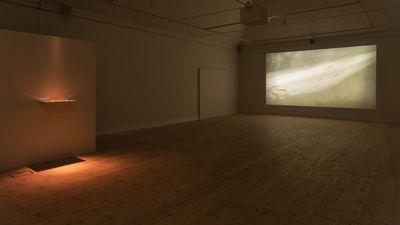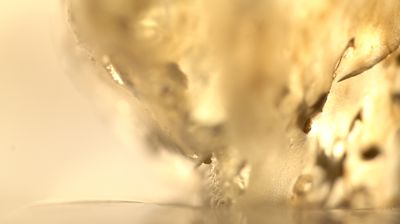Ursula NistrupCosmic Desert
–
–
The exhibition Cosmic Desert is an installation by Danish Artist Ursula Nistrup (b. 1974). Combining a video work and a series of jewellery objects, Nistrup conjures up a poetic and speculative narrative about geological processes and the enigmatic traces left behind by a remote past in our present day.
The pivotal hub of Cosmic Desert is the substance known as Libyan desert glass, which can be found in the Western part of the Sahara near the borders of Libya. This unique type of glass was presumably created when a meteorite struck the area 29 million years ago, the high temperatures of the impact immediately transforming desert sand into glass. Scientific studies of the composition of the desert glass supports this theory, but given that no impact crater has been found in the area, the origins of this desert glass remain the object of speculation. This air of uncertainty and mystique forms the basis of Nistrup’s exhibition.
In the film Journey into Deep Materiality, the camera pans slowly and inquisitively around and into a piece of desert glass, its surface reminiscent of a dramatic landscape. The probing close-ups also reveal the inner folds and furrows of this semi-transparent material, allowing the contours of crystals to emerge in glimpses. The soundtrack merges the tinkling of a glass harmonica with recordings from the desert. The realm of desert glass is shown to be full of crackles, drips, reverberations and susurrating murmurs, evocatively conjuring up the experience of travelling into the deep geological time of desert glass.
The work In Praise of the Glass Witnesses consists of a series of jewellery made of giled silver, incorporating pieces of desert glass. The series is inspired by the Cataglyphis ants, a species native to the Sahara – and the one animal on earth capable of surviving the highest temperatures. The ‘glass witnesses’ mentioned in the title is a reference to this ant species: might the Cataglyphis ants have observed and survived a potential meteorite strike some 29 million years ago, transforming desert sand into desert glass? Juxtaposed with the close visual scrutiny of desert glass evident in the film, the jewellery objects remind us that humanity’s knowledge and insights are rarely superior to nature’s own.
The video is created in collaboration with film photographer Adam Jandrup, film editor Søren Thilo Funder and sound designer Peter Albrechtsen. The jewellery objects were developed by Nistrup in collaboration with the American jewellery designer Victoria Mingot.
Parallel to the exhibition in Kunsthal Aarhus, Nistrup also presents the solo show From the Pink Sand at Holstebro Kunstmuseum. Here, too, the pivotal theme of the exhibition explores the ability of living organisms to adapt to extreme conditions. Together, the two exhibitions offer up a narrative about the sheer wonder of life, about the survival of species and the planet’s endless capacity for life. Nistrup has collaborated with Author Ida Marie Hede in preparing the dramatic structure of the overall exhibition project, and their efforts are reflected in a poetic, fragmented text connecting the exhibitions in Aarhus and Holstebro.
Ursula Nistrup is a graduate from the Glasgow School of Art and the California Institute of the Arts.
The exhibition at Kunsthal Aarhus is curated by Rebekka Elisabeth Anker-Møller.
Supported by



”Ursula Nistrups kunst i Aarhus og Holstebro er i berøring med det, vi kunne kalde miljøbevidst kunst, men ikke på den aktivistiske måde. Der er lyde som smuk munkesang sat sammen af sus. Kunsten fremtryller ukendte livsformer og historier, som er urgamle. De svimlende tidsforløb og originale synsvinkler udvider de perspektiver, vi mennesker normalt begrænses af.”
Information, Kjel Røed, 21.03.2019.
”Lyden er som altid hos Nistrup katalysatoren, og udstillingens lydspor driver ind i kroppen, hvor det brummer, knaser, runger og suser ubestemmeligt men aldeles nærværende i knoglerne og blodet, mens man transporteres ind i en fjern og ubegribelig geologisk tid.”
Kunsten.nu, Ole Bak Jakobsen, 08.03.2019


